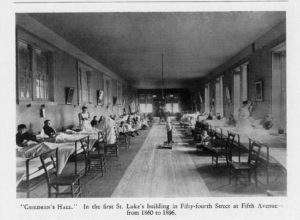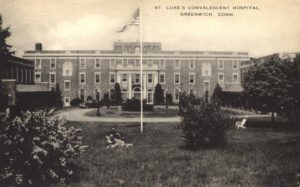When St. Luke’s Hospital was in the planning stages, it was Rev. Muhlenberg’s wish that the Hospital maintain a mission of charity, and that no suitable applicant be turned away, regardless of his or her ability to pay for treatment. The wards for men and women were designed with large windows to allow in sunshine and fresh air, as it was felt that these elements, along with good food, were essential for providing a cheery atmosphere in which to recover good health.
 However, the Managers soon realized a need they had overlooked: the number of sick children needing treatment. The 1860 annual report notes that one of the smaller rooms was set up as a Children’s Hall, to separate youngsters from the adults, which makes sense, as they probably needed more attention from the nursing staff.
However, the Managers soon realized a need they had overlooked: the number of sick children needing treatment. The 1860 annual report notes that one of the smaller rooms was set up as a Children’s Hall, to separate youngsters from the adults, which makes sense, as they probably needed more attention from the nursing staff.
The Trustees’ report for 1865 lists two big wants: “more room for sick children, because the apartment given them is always more than full” and “a ward for boys above the age of childhood, who are now mixed with adults, but in view of their moral interests, ought to be separate.” Judging by later reports, this may have been for boys below the age of 15 years. Annual reports list as many as 150 children needing care a year.
Many of the children brought to St. Luke’s had orthopedic problems, particularly hip joint diseases, and spinal issues. The first specialty services established at St. Luke’s was Orthopedic Surgery, opened primarily to treat pediatrics patients such as these. However, the mission of the Hospital was to treat and heal, and these cases often required prolonged rehabilitation on-site. The Board of Managers reached out to Hospital benefactors for solutions.
In 1868, the Hospital received the gift of a country estate in King’s Park, Long Island, courtesy of Mrs. C.L. Spencer and her niece Miss Wolfe. Called St. Johnland, it was a convalescent home for crippled or disabled children and many of the children of St. Luke’s went there to rehabilitate, recuperate, and enjoy the fresh air and sunshine of the country environment. Later annual reports note that children at St. Johnland did the typesetting and printing of these reports, which suggests that some children had trade training, perhaps so they could earn a living once they were discharged from Hospital care.
Another concern of Rev. Muhlenberg and the Board of Managers was care for the infirm elderly, especially elderly men with no family. Part of St. Johnland became a nursing home for them, answering both concerns. St. Johnland functioned as a rehabilitation home for children until the early 1950s, when its Board of Trustees decided to focus on the elderly population exclusively. St. Johnland still functions as an elder care center today.
In the mid-1880s to mid-1890s, a large summer cottage in Great Neck, Long Island was made available to St. Luke’s as a convalescent home by the generosity of Mrs. And Mrs. Edmund C. Stanton. Sick children from the Hospital spent their summers there, away from the heat and closeness of the city with accompanying nurses. A Hospital Attending made weekly visits to check on the children. Other summer homes were loaned to St. Luke’s for use as convalescent homes from time to time.
In 1925, Mrs. Hicks Arnold donated her estate of several hundred acres in Greenwich, Connecticut, called Byram Woods, to St. Luke’s Hospital. It came with an additional one million dollars for the construction of a convalescent hospital and the establishment of an endowment for its upkeep.
The Byram Hills Convalescent Home opened in 1927 and provided a healthy place to recuperate in a country setting, with the requisite fresh air and sunshine for hundreds of children. As times, and medical practice, changed and the Byram Hills facility aged, it eventually became outdated. In November 1964 Byram Hills was closed and sold.
